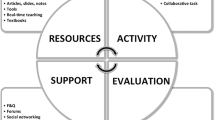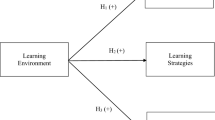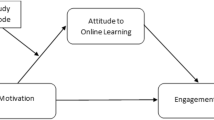Abstract
Teachers and students have their own perceptions of education. Congruent perceptions contribute to optimal teaching–learning processes and help achieving best learning outcomes. This study investigated patterns in differences between students’ and teachers’ perceptions of their learning environment. Student profiles were identified taking into account the degree of congruence/friction with teachers’ perceptions. Teacher profiles were identified based on their differences in perceptions to students. Profiles were validated with regard to learning-related student characteristics and approaches to teaching. Tenth graders (N = 994) of four secondary schools filled out the Inventory of Perceived Study Environment-Extended (IPSEE) and the Inventory of Learning Styles. Their teachers (N = 136) filled out the teacher version of the IPSEE and the Approaches to Teaching Inventory. Latent class analyses were conducted to define profiles with respect to the magnitude of differences in perceptions. Results showed three student profiles: Closest match profile (30 %), intermediate profile (59 %), and distal profile (11 %). While closest match students had desirable learning-related characteristics, others did not and are at risk for destructive friction. Two teacher profiles described idealistic teachers (70 %) and adaptive teachers (30 %), which related to approaches to teaching. Subgroups of students and teachers provide a comprehensive picture of those who are at risk because of too large differences in perceptions. This study stresses that differences in perceptions deserve detailed attention for optimising learning environments. Involving both students and teachers in the instructional design process could be a way to better account for perceptions of both stakeholders.





Similar content being viewed by others
References
Bargh, J. A., Chen, M., & Burrows, L. (1996). The automaticity of social behavior: Direct effects of trait concept and stereotype activation on action. Journal of Personality and Social Psychology, 71, 230–244.
Broekkamp, H., Van Hout-Wolters, B. H. A. M., Rijlaarsdam, G., & Van den Bergh, H. (2002). Importance in instructional text: Teachers’ and students’ perceptions of task demands. Journal of Educational Psychology, 94, 260–271.
Cook-Sather, A. (2003, March/April). Listening to students about learning differences. Teaching Exceptional Children, pp 22–26.
De Corte, E., Verschaffel, L., Entwistle, N., & van Merriënboer, J. J. G. (Eds.). (2003). Powerful learning environments: Unravelling basic components and dimensions. Oxford: Elsevier Science.
Den Brok, P. J., Bergen, T. C. M., & Brekelmans, J. M. G. (2006). Convergence and divergence between students’ and teachers’ perceptions of instructional behaviour in Dutch secondary education. In D. L. Fisher & M. S. Khine (Eds.), Contemporary approaches to research on learning environments: World views (pp. 125–160). Singapore: World Scientific.
Donaldson, M. (1978). Children’s mind. London: Fontana.
Doppelt, Y. (2004). Impact of science-technology learning environment characteristics on learning outcomes: Pupils’ perceptions and gender differences. Learning Environments Research, 7, 271–293.
Eccles, J. S., Wigfield, A., Midgley, C., Reuman, D., Mac Iver, D., & Feldlaufer, H. (1993). Negative effects of traditional middle schools on students’ motivation. The Elementary School Journal, 93, 553–574.
Elen, J., Clarebout, G., Léonard, R., & Lowyck, J. (2007). Student-centred and teacher-centred learning environments: What students think? Teaching in Higher Education, 12, 105–117. doi:10.1080/13562510601102339.
Elen, J., & Lowyck, J. (1999). Metacognitive instructional knowledge: Cognitive mediation and instructional design. Journal of Structural Learning & Intelligent Systems, 13, 145–169.
Entwistle, N., & Tait, H. (1990). Approaches to learning, evaluations of teaching, and preferences for contrasting academic environments. Higher Education, 19, 169–194.
Feinstein, L., & Peck, S. C. (2008). Unexpected pathways through education: Why do some students not succeed in school and what helps others beat the odds? Journal of Social Issues, 64, 1–20. doi:10.1111/j.1540-4560.2008.00545.x.
Fraser, B. J. (1998). Classroom environment instruments: Development, validity and applications. Learning Environments Research, 1, 7–33.
Fraser, B. J., & O’Brien, P. (1985). Student and teacher perceptions of the environment of elementary school classrooms. The Elementary School Journal, 85, 567–580.
Kember, D. (1997). A reconceptualisation of the research into research into university academics’ conceptions of teaching. Learning and Instruction, 7, 255–275.
Kershner, R., & Pointon, P. (2000). Children’s views of the primary classroom as an environment for working and learning. Research in Education, 64, 64–77.
Könings, K. D., Brand-Gruwel, S., & van Merriënboer, J. J. G. (2005). Towards more powerful learning environments through combining the perspectives of designers, teachers and students. British Journal of Educational Psychology, 75, 645–660. doi:10.1348/000709905X43616.
Könings, K. D., Brand-Gruwel, S., & van Merriënboer, J. J. G. (2007a). Teachers’ perspective on innovations: Implications for educational design. Teaching and Teacher Education, 23, 985–997. doi:10.1016/j.tate.2006.06.004.
Könings, K. D., Brand-Gruwel, S., van Merriënboer, J. J. G., & Broers, N. (2008). Does a new learning environment come up to students’ expectations? A longitudinal study. Journal of Educational Psychology, 100, 535–548. doi:10.1037/0022-0663.100.3.535.
Könings, K. D., van Zundert, M. J., Brand-Gruwel, S., & van Merriënboer, J. J. G. (2007b). Participatory design in secondary education: Its desirability and feasibility according to teachers and students. Educational Studies, 33, 445–465. doi:10.1080/03055690701423648.
Lee, M. H., & Tsai, C. C. (2005). Exploring high school students’ and teachers’ preferences toward the constructivist Internet-based environments in Taiwan. Educational Studies., 31, 149–167. doi:10.1080/03055690500095522.
Luyten, L., Lowyck, J., & Tuerlinckx, F. (2001). Task perception as a mediating variable: A contribution to the validation of instructional knowledge. British Journal of Educational Psychology, 71, 203–223.
Murphy, L. M., Shelley, M. A., White, C. J., & Baumann, U. (2011). Tutor and student perceptions of what makes an effective distance language teacher. Distance Education, 32, 397–419. doi:10.1080/01587919.2011.610290.
Norman, D. A. (1986). Cognitive engineering. In D. A. Norman & S. W. Draper (Eds.), New perspectives on human-computer interaction (pp. 31–62). Hillsdale NJ: Lawrence Erlbaum Associates.
Prosser, M., & Trigwell, K. (1993). Development of an approaches to teaching questionnaire. Research and Development in Higher Education, 15, 468–473.
Prosser, M., & Trigwell, K. (1997). Relations between perceptions of the teaching environment and approaches to teaching. British Journal of Educational Psychology, 67, 25–35.
Renzulli, J. S., & Dai, D. Y. (2001). Abilities, interests, and styles as aptitudes for learning: A person-situation interaction perspective. In R. J. Sternberg & L. Zhang (Eds.), Perspectives on thinking, learning, and cognitive styles (pp. 23–45). Mahwah, NJ: Lawrence Erlbaum Associates.
Roelofs, E. C., & Terwel, J. (1999). Constructivism and authentic pedagogy: State of the art and recent developments in the Dutch national curriculum in secondary education. Journal of Curriculum Studies, 31, 201–227.
Rost, J. (2004). Testtheorie und Testkonstruktion [Test theory and test construction]. Bern: Hans Huber.
Schmitt, N., Oswald, F. L., Friede, A., Imus, A., & Merritt, S. (2008). Perceived fit with an academic environment: Attitudinal and behavioural outcomes. Journal of Vocational Behavior, 72, 317–335. doi:10.1016/j.jvb.2007.10.007.
Seidel, T. (2006). The role of student characteristics in studying micro teaching-learning environments. Learning Environments Research, 9(3), 253–271. doi:10.1007/s10984-006-9012-x.
Shavelson, R. J., & Seidel, T. (2006). Approaches in measuring learning environments. Learning Environments Research, 9(3), 195–197. doi:10.1007/s10984-006-9010-z.
Trigwell, K., Prosser, M., & Waterhouse, F. (1999). Relations between teachers’ approaches to teaching and students’ approaches to learning. Higher Education, 37, 57–70.
Van Merriënboer, J. J. G., & Kirschner, P. A. (2012). Ten steps to complex learning (2nd ed.). New York: Routledge.
Vermetten, Y. J., Vermunt, J. D., & Lodewijks, H. G. (2002). Powerful learning environments? How university students differ in their response to instructional measures. Learning and Instruction, 12, 263–284.
Vermunt, J. D. H. M. (1992). Leerstijlen en sturen van leerprocessen in het hoger onderwijs: Naar procesgerichte instructie in zelfstandig denken [Learning styles and regulations of learning in higher education: Towards process-oriented instruction in autonomous thinking]. Amsterdam/Lisse: Swets and Zeitlinger.
Vermunt, J. D. (2007). The power of teaching-learning environments to influence student learning. British Journal of Education Psychology Monograph Series II, 4, 73–90.
Vermunt, J. D., Bouhuijs, P. A. J., & Picarelli, A. (2003). Vragenlijst Leerstijlen voor het Voortgezet Onderwijs (VLS-VO) [Inventory of Learning Styles for Secondary Education (ILS-SE)]. Maastricht University, The Netherlands: Expertise Center Active Learning.
Vermunt, J. D., & Verloop, N. (1999). Congruence and friction between learning and teaching. Learning and Instruction, 9, 257–280.
Vermunt, J. D., & Vermetten, Y. J. (2004). Patterns in student learning: Relationships between learning strategies, conceptions of learning, and learning orientations. Educational Psychology Review, 16, 359–384. doi:10.1007/s10648-004-0005-y.
Von Davier, M. (1999). WINMlRA: A program system for analyses with the Rasch-model, with the latent class analysis and with the mixed-Rasch model. Kiel: IPN.
Watkins, D. (2004). Teachers as scholars of their students’ conceptions of learning: A Hong Kong investigation. British Journal of Educational Psychology, 74, 361–373.
Wierstra, R. F. A., Kanselaar, G., Van der Linden, J. L., & Lodewijks, H. G. L. C. (1999). Learning environment perceptions of European university students. Learning Environments Research, 2, 79–98. doi:10.1023/A:1009962024666.
Author information
Authors and Affiliations
Corresponding author
Appendix
Appendix
See Table 7.
Rights and permissions
About this article
Cite this article
Könings, K.D., Seidel, T., Brand-Gruwel, S. et al. Differences between students’ and teachers’ perceptions of education: profiles to describe congruence and friction. Instr Sci 42, 11–30 (2014). https://doi.org/10.1007/s11251-013-9294-1
Received:
Accepted:
Published:
Issue Date:
DOI: https://doi.org/10.1007/s11251-013-9294-1




